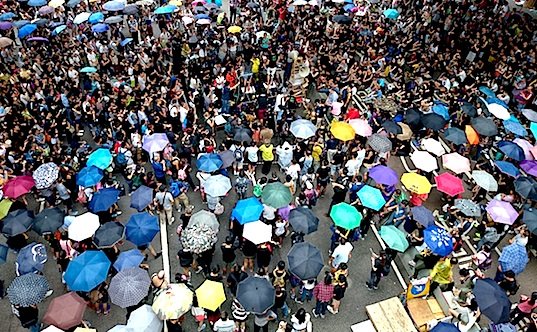In 1989, just after college, I moved to Beijing to teach English to Chinese graduate students. I was in Tiananmen Square when the tanks rolled in and fled on my bike in a panic just before the shooting started. I made it back to the college in Southeast Beijing where I was teaching, but all night I heard gunshots just outside my window as students tried to prevent troops and tanks from moving toward the Square. The next day I learned that three student protestors from our college had been killed.
Twenty-five years later, that experience still haunts me. It also means that I have a deep emotional investment in Hong Kong’s Umbrella Revolution. The current popular uprising among Chinese students gives me hope that the movement that started in Tiananmen Square a quarter-century ago is still alive and that the goal of a more democratic and equitable China is attainable. Yet the specter of Tiananmen Square also causes me to fear that another violent crackdown might be be unleashed on this new generation of protesters.
As a sociologist of religion, I’m fascinated by the fact that churches and Christian leaders have been integrally involved in these Chinese protests (see CRCC’s interview with Samuel Chu), much like the Solidarity movement in Poland in the 1980s. This also makes me fear for religious groups all over China, as the Chinese government’s suspicion that religious groups are a threat to its rule is seemingly coming true. Groups that are perceived as a threat to the government do not typically fare well in China.
Yet I am convinced that a large-scale crackdown on religion in China is unlikely to come in the wake of the Umbrella Revolution. Much has changed in the country since 1989. Most notably, as a recent article in the Economist observed, there are probably more Christians in China now than there are members of the 87 million-strong Communist Party.
Most of these Christians are evangelical Protestants. Many new NGOs have been set up by Christians, and there are now over 2,000 Christian schools in China, even though they are technically illegal. Of the top 50 civil rights lawyers in China, half are Christian. A decade ago, I read an article in a Chinese publication that claimed that 3-4 million Communist Party members had become Christians. According to the writer in the Economist, the sheer numbers and influence of Christians in China has forced the government to rethink its opposition to religious belief and independent religious organizations.
It strikes me that politically engaged religious leaders in the U.S. have much to learn from the Umbrella Revolution and the Christian movement in China. Religious groups in China and Hong Kong have been able to influence policy because 1) their constituencies are too large to ignore and now include influential business and government leaders, 2) they have earned credibility through tireless service to their communities and 3) when the moment is ripe, their leaders have been willing to use their political and social capital to pressure those in power for change.
In America, we seem to have two types of religious leaders. On the one hand, there are those who have large and potentially influential constituencies, but who are usually unwilling expend their credibility and social capital by joining movements for equality and justice. On the other hand, the leaders who are most politically active in causes for justice and equality often have less influence because their institutions and constituencies are small and shrinking. Many leaders in the former group believe that the political activism of the latter group is the reason for its diminishing influence, which means that many potential advocates for positive social change hang back for fear of alienating their large constituencies by become politically active.
It seems that the most powerful religious movements for social change–like the Umbrella Revolution, Solidarity and the Civil Rights movement–become powerful only because they are built on a legacy of many years spent faithfully connecting people to God, building institutions and serving their communities–the often thankless work that constitutes the bulk of religious leaders’ lives.
When a powerful, faith-inspired social movement emerges, it is because influential religious leaders have decided that the time is ripe to use their hard-won influence to support a worthy–and sometimes risky–cause. It seems that these stars align only once in a generation or so. We are witnessing another such alignment now. Let’s watch, learn, celebrate and pray for a peaceful breakthrough.
Brad Christerson is a contributing fellow with the Center for Religion and Civic Culture.








